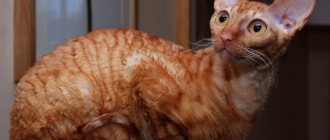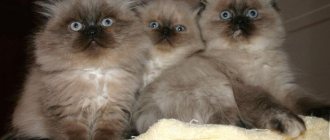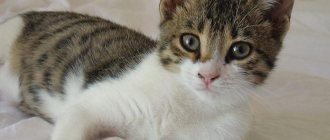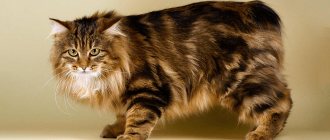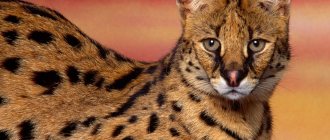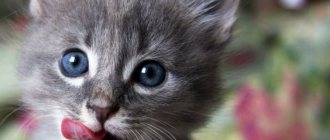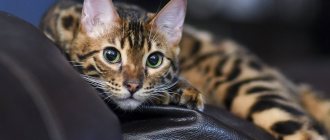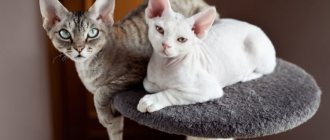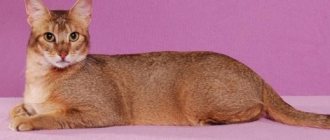Video
* We invite you to watch a video about the Selkirk Rex . In fact, in front of you is a playlist in which you can select and watch any of 20 videos about a given cat breed by simply clicking on the button in the upper right corner of the window. In addition, the material contains quite a lot of photos. By looking at them you can find out what a Selkirk Rex looks like.
In this article:
|
Rate the material!
[Total votes: 2 Average: 5]
The Selkirk Rex is a charming creature with an original appearance. These cats either resemble Persians with Afro-style carvings or British cats dressed in sheepskin coats. A typical urban sofa breed, it does not shine with ingenuity and is not prone to noisy games.
Care
The main care for a cat of this breed consists of daily combing of its curly fur. It is recommended to brush long-haired pets at least twice a day during shedding.
If this procedure is neglected, the cat's fur begins to become very tangled, tangles appear, which take a long time to untangle, causing pain to the animal, or to be cut off in large pieces, which significantly spoils the appearance of the pet.
Selkirk Rexes are prone to skin diseases if the owner does not provide regular water treatments for cats. It is recommended to bathe animals once every 1-2 months. When drying your Selkirk Rex, you should not use a hairdryer.
Nutrition
In general, the diet of Selkirk Rex cats is not very different from the diet of other cats. You can feed them the same premium food or prepare your own food from natural products and give the animals additional vitamins.
The peculiarity of feeding cats of this breed is that they can easily eat the entire contents of their bowl at one time. It is best if the owner carefully monitors the volume of portions so that the pets do not become overweight.
Health and illness
The Selkirk Rex breed has fairly good health, but the owner should pay special attention to caring for his pet's eyes. If the cat cleans its own eyes and the owner bathes it regularly, there should be no problems.
To prevent any diseases, it is recommended to conduct regular examinations at veterinary clinics.
History of the origin of the Selkirk Rex
The Selkirk Rex is a breed from the so-called “Rex” group. It includes cats and other animals - carriers of a mutation that manifests itself as curly hair. Genetically the closest to this breed are Devon Rexes and Hairless Sphynxes, whose abnormal coats are caused by different alleles of the same mutated gene.
The first cat, the founder of the Selkirk Rex breed, was born in Montana (USA) in 1987 from an unnamed cat. Breeder Jeri Newman noticed the curly-haired offspring among the usual brothers and named the cat Miss Di Pesto in honor of the heroine of the television series Moonlight Detective Agency, who had similar hair. The promising cat was bred to a black Persian and gave birth to six kittens, half of which turned out to be the spitting image of their mother.
The result showed that the mutated gene is inherited in an autosomal dominant manner. That is, curly cats will consistently appear in any litter. Geri Newman christened the breed "Selkirk" in honor of her stepfather: this is the first and so far only breed named after a real person (and not a mountain, as in some versions).
This was followed by outcrosses with American Shorthairs, Persians, Himalayans, exotic KShs and British KShs to enrich and diversify the genotype, which made it possible to significantly increase the number without resorting to inbreeding. In this way, a healthy population with rich genetic potential can be created.
The breed was accepted by the International Cat Association (TICA) in 1992, the American Cat Fancier's Association (ACFA) in 1998 and the Cat Fancier's Association (CFA) in 2000, and is also recognized by the WCF. The Cat Fancier's Association (CFA) and Australia stopped all outcrossing in 2015. FIFe does not recognize this breed.
Selkirk Rex cats are inferior in popularity to Devon Rex and Sphynx cats, not making it into the top ten.
Selkirk Rex appeared in Russia at the end of perestroika. Now they are bred by about 20 nurseries in the country, usually together with the British and Scottish.
Kittens
A kitten's curly fur tends to straighten out some time after birth, after which the curls appear again at the age of about eight months and the cat becomes the same as before.
When choosing a Selkirk Rex kitten, it is difficult to determine whether it will subsequently have curly hair. A mustache can serve as a clue for the future owner. Smooth-haired cats have straight whiskers, while curly-haired cats have whiskers that curl downward.
Selkirk Rex - description of the breed
According to the CFA standard, the Selkirk Rex breed is distinguished primarily by a soft, curly coat without a clear division into undercoat and guard hairs. Medium to large cats with strong bones give the impression of physical strength. Kitties are somewhat smaller than cats, but have the same strong build. The character is affectionate and balanced. There are two varieties of Selkirk Rex: longhair and shorthair.
More details:
- The head is round, with a wide face and pronounced cheeks. Well-developed whisker pads give the muzzle a somewhat angular appearance. The length of the muzzle is equal to half its width. In profile it can be seen that the chin and the tip of the nose lie on the same line;
- The nose curves somewhat, like a classic Persian, but without a sharp stop;
- Curled mustache and eyebrows;
- The ears are medium, with wide bases, set wide apart; fit into the circle of the facial contour. The fur in the ears is also curly;
- The eyes are round, large and spaced. Acceptable colors: green, yellow, copper, blue (for white solids, vans, colorpoints). With a white color, there may be different eyes;
- The body size is medium to large, it itself is foldable, rectangular, not long. The shoulders and pelvis are approximately the same width;
- The legs are strong and proportional. Paws are powerful, round;
- The tail is of medium length, thick at the base and rounded at the end.
The coat comes in two styles – long and short, which is especially clearly demonstrated by the tail and collar. Short-haired cats have fur 1-2 cm long. It is dense, like plush, of the same length on the tail, collar and body. The curls are compact, resembling random lumps.
Long-haired cats have fur that does not lie tightly. It is especially long on the tail and the collar surrounding the muzzle. The curls are messy, rings and lumps, like a zigzag curl. Particularly noticeable on long hair.
Herman rex
This breed appeared in Germany thanks to the crossing of a Russian Blue cat with an Angora cat. Later, European Shorthairs took part in its breeding.
There were times when the breed was almost completely exterminated. We had to start the selection all over again, so the shades of coat and exterior faded into the background. The main goal was to obtain a characteristic coat texture - without undercoat, soft and with curls resembling astrakhan fur.
Representatives of the breed are very smart and loyal, cheerful and energetic. Moderately curious and inquisitive. The happy owners of these cats are very glad that they chose this particular breed.
Popular Selkirk Rex colors
A variety of cats took part in the formation of the breed, including multicolored Persians.
All colors of the Selkirk Rex are acceptable:
- Color points are colors like Siamese cats, when the face, legs and tail are dark and the body is light. Depending on the colors and shades, there are about 20 varieties of this color. Seal point and blue point are especially popular. Or they are called by the names of the breeds, Burmese type, Siamese type, etc.;
- Solids are one-color. Any colors, including diluted ones: blue and cream. The lilac and chocolate colors inherited from the British are interesting. Lilac is a delicate color of varying intensity, from café au lait to a very pale shade;
- Bicolors are two-color colors that combine spots of any color, including white. Van is over 90% white, with spots only on the ears and a colored tail. The harlequin is similar, but has several colored spots on the back;
- Turtles have colorful coats, combining black and red or blue and cream, preferably a bright spot (light) on the face;
- Calico is a turtle with white. The so-called “tricolored” cats bring happiness. Or money, whoever understands happiness;
- Tabby - with spotted, striped (mackerel-shaped), marbled patterns of any color on any background. May be ticked, that is, hairs with dark ends;
- Chinchillas have hairs with dark tips, any color. The most common are silver and gold;
- Smoke - hairs are half dark, any colors, but mostly black, blue, chocolate, red.
Often different types of colors are combined on one small cat and then they are all listed. For example, the red tortoiseshell tabby van.
Cornish Rex
This is a very ancient breed of cat. It appeared in Britain in the 50s, but was recognized only 17 years later. The first kitten appeared on a farm where they were breeding rabbits. To consolidate the breed, they began to be crossed with Siamese and ordinary domestic cats.
The appearance of this cat is lean and tall, but the body is very graceful and graceful. The ears are very large, set wide apart and look in different directions, the muzzle is elongated, and the eyes are large. The legs and tail are long and graceful relative to the body.
The Cornish Rex is very similar to the Sphynx, but with wavy fur. It differs in that it does not have main hairs, but is an undercoat. Such cats resemble in their appearance a Karakul lamb.
These are sociable and inquisitive cats. They easily find a common language with everyone. They are very smart, very loyal and friendly, and amenable to training.
Character and habits of the Selkirk Rex
Selkirks produce a blissful, pastoral impression with their round, big-eyed face and sheep-like curls. You just want to caress them, scratch them and listen to how they continue their endless monotonous rumbling. A comforting animal to play with from the comfort of your couch.
The character of the Selkirk Rex combines the traits of all the breeds that created it. Here you can find the relaxed restraint of the British Shorthair, the gentle charm of the Persian nature, the good nature and accommodating nature of the American Shorthair and the playfulness of the Exotic Shorthair. These qualities create a great variety of combinations that give individuality to each representative of the breed.
Selkirk Rexes are cheerful, but balanced and not prone to unbridled fun; they do not have the need to rush around the house, demanding that those around them take part in the bacchanalia. They are affectionate and patient - valuable qualities when it comes to performing hygiene or medical procedures, such as cleaning their ears.
Pets of this breed are tolerable with other pets and children. They will not harm the kids and will become their playmates when they grow up. They get along well in large and large families. They are ideal companions for single people.
Selkirks are gentle and affectionate with their owner, they love to lie on their laps or in their arms, sit on the table, watching him work, and are always ready to cuddle. They can be cuddled and worn around the neck like a boa. Cats are patient enough to tolerate such familiarity. There really is something sheepish about them.
With the equanimity of a British butler, they greet strangers and express pleasure in making his acquaintance. They don't panic at unexpected noises and aren't even afraid of the vacuum cleaner! But innate character traits and temperament are one thing, upbringing is another. A calm, balanced pet will grow up only in a home where there is peace and smooth, friendly relationships.
Character
The Selkirk Rex cat is rightfully considered a companion pet. According to breeders, they have absorbed the best features of other domestic cat breeds. These cats are very affectionate, sweet and playful animals.
The character of the Selkirk Rex is similar in loyalty to that of a dog; they remain devoted to their owners, but do not require special attention. Due to the fact that cats are very sociable and curious, but quite calm, they can be safely adopted in families with small children.
Interesting facts about the Selkirk Rex
Let's see what interesting things you can learn about the Selkirk Rex:
- The original type of coat in the Selkirk Rex is determined by a dominant mutation of the KRT71 gene, which encodes the formation of keratin (building material) of hair and epithelium. The Devon Rex had a mutation in the same gene, but it was recessive. The hairless sphinx was also the result of the KRT71 mutation. But in Cornish and German Rex, other parts of the chromosomes were mutated;
- The rex mutation occurs in a variety of mammals: cats, dogs, humans, horses, rats and rabbits. Phenotypically, it is expressed in the appearance of curly hair with a soft texture and curled whiskers. The mutation occurs suddenly and affects different genes responsible for the properties of wool. Therefore, animals with the rex mutation can have different hair: long, short, thick or sparse, of varying thickness and curl pattern;
- The first Rex cats were seen in England in Cornwall in 1950 and in Devon in 1960 and were named Cornish Rex and Devon Rex respectively. They appeared in litters of European KSH. Besides them and the Selkirk, only the Laperm breed is officially recognized by leading felinologists. Mutants appeared in different regions, among different breeds and among nobles. About a dozen rexes have been described, including the Ural rex. But they, with rare exceptions, did not become widespread and disappeared;
- Among the breeds in the Rex group, the Selkirk Rex is one of the youngest. It stands out among others with its relatively dense body, round head and small ears. All other rexes are built more like oriental breeds - thin, graceful and with bat ears. It has been suggested that the Rex mutation is also responsible for the ears, since homozygous individuals will deviate into the eastern type.
Rex
Rexes make up a whole group of cat breeds, divided into subspecies. An interesting fact is that representatives of the breeds appeared naturally. Kittens can be born with completely straight hair; it curls over time. It is generally accepted that curliness is the result of a gene mutation. However, when they saw the cute curly-haired cats, breeders fell in love with them and decided to develop breeds of curly-haired cats. As a result of their work and crossings, more and more kittens with curly hair were born. These cats have an unusually attractive appearance and good disposition. For this they have become popular all over the world.
Pros and cons of the Selkirk Rex
Representatives of the breed have enough advantages to confidently call them desirable pets. They are very attractive, but not with the cold beauty of the Siamese breed, but with the warm and cozy charm of a pillow that you just want to take to your lap.
Selkirk is very calm and balanced, and does not throw tantrums due to discomfort, for example, if he is not picked up the way he likes. These cats can tolerate quite rough treatment from children and dogs. Sanitation and medical procedures are accepted with understanding.
Cats of this breed do not shine with special intelligence, but they are smart enough to learn the rules of behavior in the house. Learn the prohibitions on visiting the table and acquire skills in using the tray. They seem to be created for city apartments, although their ancestor was a natural tramp.
Selkirks are cheerful and playful without fanaticism. They love to have fun with toys and their play sets, both alone and with the participation of the owner. They do not go into a frenzy during play, using their claws and teeth. They don’t pounce from around the corner to tear the slipper along with the foot. They are mostly silent, and if they meow, it is quietly and melodiously. As they say, “they won’t muddy the waters.”
One big disadvantage of the Selkirk Rex is not difficult to find - it is not used for catching mice. In any case, they only write that he plays with toy mice. Considering the cost of purebred individuals, it is somehow inconvenient to send them to the street for food.
Another feature of the cat that may not appeal to everyone is its affection and thirst for company. He feels bad being alone, which spoils even his angelic character. Selkirk should live in a large family or with a homebody owner.
Ural rex
The Ural rexes appeared completely by accident, thanks to Mother Nature. Such kittens were considered defective, sick and destroyed, thereby reducing the breed to a few individuals. Years later, one cat gave birth to curly-haired kittens. Breeders paid attention to this; they did not miss the opportunity to breed and reproduce this breed.
These are medium-sized cats with a powerful, muscular body. The eyes are large almond-shaped. Their fur is dense and dense, and can be medium-length or short. Due to the presence of large curls, it is difficult for the rex during molting. Lost hairs can get stuck in your hair. The owner’s task is to comb the fur with a special one so that all unnecessary hairs fall off. The character of these cats is characterized by cheerfulness, simplicity and kindness.
Breeding Selkirk Rex
To breed a Selkirk Rex, it is important to know the laws of genetics at least within the limits of high school. There are three possible combinations involving the rex mutation. The breed standard refers to the appearance of a heterozygous cat, which has one mutant gene and one normal gene (produces straight hair). Such cats are the most beautiful, endowed with especially lush and thick hair. They dominate exhibitions.
Interesting fact: Heterozygotes produce different numbers of curly-haired kittens depending on the genotype of the partner. 50 x 50 will be obtained when mating them with straight-haired cats; more than half of the litter will be curly-haired in a union of two heterozygotes. In any case, a fairly high percentage of the desired phenotype is obtained.
Homozygous straight-haired cats (Selkirk Straights) carry only the original genes without mutation. They will not produce standard Selkirks when bred to each other or outcrossed. Such individuals are used in breeding programs because they retain all the steel characteristics of the breed, except for wool.
Homozygous cats with curly hair carry two mutated alleles. Mutations in this combination reinforce each other and their carriers are especially curly, short-haired and built like oriental breeds with their huge ears. They will produce curls in any situation, with any outcross.
Interestingly, such kittens are often born bald or go bald immediately after birth. They may have bald spots especially on the lower side of the body. It happens that they go bald at the age of 4 – 10 weeks. But in any case, babies grow overgrown by 16 - 20 weeks. It seems that such piggy banks of a valuable mutation are very useful, but they will not make a show career, and they are too similar to Devon Rex.
Breeding
The first estrus in females occurs at 9 months. But Cornish Rex cats do not begin to mate earlier than 1 year, since before this time the animal’s body has not yet fully formed and is not ready for gestation. As a result of mating too early, the offspring are often born weak and non-viable. All necessary vaccinations must be given in advance (4-5 months in advance).
Experienced breeders do not recommend breeding females before 1 year of age
The female is brought to the male's territory and left there for several days. It is better to cut the cat's claws so that she does not scratch her partner. If after a month the heat has not started, then everything went well. The duration of pregnancy is from 62 to 66 days. Usually there are no complications and childbirth is easy. Small Cornish cats are first covered with small light curls, then at about six months they shed and become overgrown with real, denser wavy hair.
From personal experience. My office neighbor had a Cornish Rex cat at home. She didn't have any documents. Bought second hand based on an ad. She was worn to mate with a purebred cat about once a year. The kittens in the litter were very different in color, but usually no more than half of them were wavy.
Caring for Selkirk Rex
It is believed that the dense and curled coat of the Selkirk Rex does not require much care. But wool is different. It varies greatly in thickness and rigidity among different individuals. Ideally, the coat of a long-haired Selkirk should have very fine and soft hair, which easily mats and forms tangles.
Each pet needs an individual approach. Particularly lush, long-haired cats are scratched every day, but they develop another problem - the curl disappears. It is visible only if the fur is divided into separate strands, but as soon as you comb them, it disappears. To restore its beauty, the cat needs to be sprayed with a spray bottle and crushed! Well, isn't this an atrocity?
Short-haired Selkirk Rexes with a dense velvet coat are scratched less often - once every two to three weeks is enough. But you will have to comb it in any case, especially since the breed, in principle, sheds a lot. Before shows, cats are subjected to a variety of procedures (such as grooming) that the cats themselves do not need. But those who admire their unearthly beauty must take into account that they don’t always look like that.
Standard procedures:
- Cleaning ears as needed;
- Trimming of nails, if the pet does not grind them down himself;
- Providing a scratching post or upholstered furniture for sharpening claws;
- Cleaning and washing the tray and bowls;
- Providing water;
- Annual vaccination against at least major viral diseases.
We especially need to remind you about castration of pets that will not go into breeding. There is no need to torment animals with useless “wants”; fluctuations in hormonal levels are not beneficial for cats, especially females. Hormonal drugs do not solve the problem, or at least they do not contribute to long life.
Selkirk Rex diet
You can feed Selkirks with natural food, ready-made food (dried and canned), or a mixture of both. You can alternate natural feeding and drying every other day or two. It’s better if the food doesn’t sit in the bowl; what’s not eaten in the evening is removed.
Kittens are fed several times a day and at first with what they are accustomed to at home. A sudden change in diet can result in indigestion. They get used to the new menu gradually, replacing part of the old one with it. The kitten is given no more than 30 - 40 ml of wet food (canned food or minced meat) at a time. You can calculate drying by following the instructions on the food bag.
The daily portion of super-premium dry food for an adult cat is 50 – 80 g or 2100-3400 kcal. Good food, both dried and canned, contains at least 50% meat. If the food is less rich in meat proteins (lower class), then more of it will have to be given, which reduces the cost savings.
Other food ingredients are no less important. It is advisable that the main sources of carbohydrates are not corn and wheat, but rice and other cereals. Such foods are less allergenic. In the end, you can immediately purchase hypoallergenic foods or those “for sensitive digestion.” Price doesn't matter. If the cat does not eat, it is impossible to force him. You'll have to buy a new one, better than another manufacturer.
Interesting fact: No matter how expensive the food is and no matter how high its rating, the main thing is that it is to your liking... that is, to your pet’s stomach. An indicator of the balance of the diet and its suitability for the cat’s body is the cat’s good health, playfulness, appetite, normal stool and vibrant, shiny fur.
Characteristics and standard
According to the standard, the average weight of a curly cat is up to 3 kg, and that of a male cat is no more than 4.5 kg. The body can be of the European type (more massive) or American (graceful). The body is harmoniously built, the torso is elongated, the back is curved.
The chest, shoulders, and hips are proportional to each other. The tail is long and thin, flexible and thickened at the tip. The limbs are slender and rather long. The head is medium, wedge-shaped or ovoid with pronounced cheekbones. The eyes are almond-shaped and are yellow, green or greenish-gold in color.
According to the standard, eye color should be in harmony with the overall coat color. Eyebrows and mustaches are long and curly. The nose is straight, “Roman” profile. Large ears are set high, they are wide with pointed ends.
Diseases and health problems
There are no known health problems specific to the Selkirk Rex breed. Except that homozygous cats may have a tendency to have excessively oily fur and require more frequent bathing. Like other victims of the Rex mutation, Selkirks may have increased earwax secretion due to irritation of the insides of the ears by the curly fur. Otherwise, they are quite strong and healthy, even though they are mutants.
If diseases occur, they are introduced by the breeds with which outcrosses were carried out. But a number of them, such as polycystic kidney disease, inherited from the Persians, were eliminated from many purebred lines. From the Persians, the Selkirks also inherited a shortened muzzle, which in extreme cases leads to lacrimation and even dermatitis due to constant dampness.
What else happens:
- Hypertrophic cardiomyopathy, heritage of the British Shorthair;
- Inflammation of the bladder (cystitis). Causes: a cold or improper feeding;
- ICD is a disease of cats and, partly, cats. Caused by hereditary predisposition and sedentary lifestyle;
- Kidney failure is a dangerous disease of various nature. Can lead to intoxication of the body and painful death. There are special foods for cats suffering from this disease;
- Food allergies, often manifested in the form of atopic dermatitis, are caused by a predisposition. The most common allergens are beef, chicken, corn, and wheat. Eliminating these ingredients from the diet or switching to hypoallergenic food helps;
- Among viral infections, panleukopenia, also known as feline distemper, is especially dangerous. A very tenacious infection that affects the stomach and intestines and develops anemia. It can be treated, but not always. It is better to get vaccinated in advance.
